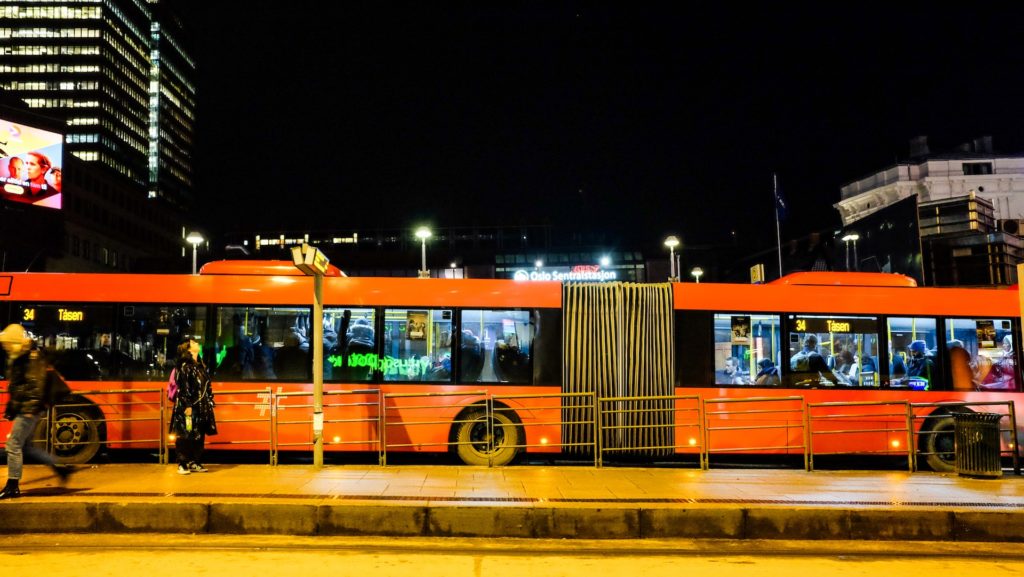It should be noted that there are certain rules for sitting on public transportation in Norway. One does not simply sit next to a stranger in this country. If you see open seats or open benches, you must always take them. Don’t just take the closest seat, which might already have someone sitting next to it. This will make Norwegians nervous, and they’ll wonder why you’re sitting so close. That’s because Norwegians only get very close to strangers when they’re incredibly drunk, not on the commute home from work at 3:30 p.m.
You also don’t talk on public transportation, ever. You don’t take loud phone calls, or even chat with a friend you’re traveling with. You just sit there quietly and look out the window. Whatever you do, do not strike up a conversation with a stranger on public transportation or give them a compliment.
Finally, if you happen to be in the unfortunate situation of being on a bench and blocked from the aisle but needing to get off, don’t ask the person to move or say “excuse me.” You just kind of make a brief motion of getting up to signal them. That or you smash the stop button repeatedly so they can anticipate your move without having to speak to you.

Norway’s efficient and well-developed public transportation system is a crucial part of everyday life for its residents and a boon for travelers exploring this stunning Scandinavian nation. Comprising a network of buses, trams, trains, ferries, and even electric scooters, public transportation in Norway is known for its reliability, cleanliness, and ease of use. In this article, we’ll delve into how public transportation works in Norway, the various modes of transit, and some useful tips for those looking to get around.
- The Backbone: Trains
Trains are the backbone of Norway’s public transportation system, connecting major cities and regions with speed and efficiency. The state-owned company, Vy (formerly NSB), operates most of the long-distance trains. The railway system offers picturesque journeys through Norway’s stunning landscapes, including fjords, mountains, and picturesque villages. High-speed trains such as the Airport Express Train (Flytoget) connect Oslo Airport to the capital, Oslo, in just 19 minutes, making it a convenient choice for travelers.
- Buses for Local Travel
Buses are an essential mode of transportation for local and regional travel. Norway boasts an extensive bus network that connects even the remotest villages to major cities. The state-owned company, Ruter, is responsible for buses in Oslo, while other cities have their own regional transportation authorities. The bus routes are well-maintained, and modern, comfortable vehicles make commuting a breeze.
- Metro and Trams
Major cities like Oslo, Bergen, and Trondheim have efficient metro and tram systems. Oslo’s T-bane (metro) and trikken (trams) provide a reliable and convenient way to get around the capital. The tram system in Bergen is particularly known for its stunning scenic route to Mount Fløyen.
- Ferries and Boats
In a country with an extensive coastline and countless fjords, ferries and boats are integral to the transportation network. They connect islands, small coastal communities, and provide incredible scenic cruises. One of the most famous ferry routes is the Hurtigruten, which sails along the coast from Bergen to Kirkenes and is sometimes referred to as the “world’s most beautiful sea voyage.”
- Taxis and Ride-Sharing
Taxis are readily available in cities and towns, but they can be relatively expensive. Ride-sharing services like Uber are also an option in some urban areas. However, public transportation is often more economical and efficient for city travel.
- Biking and Electric Scooters
Norway’s cities are bicycle-friendly, with dedicated bike lanes and rental options. In addition, electric scooters have become increasingly popular for short journeys, offering a convenient way to get around urban areas.
- Fares and Tickets
To use public transportation in Norway, you typically need a ticket or travel card. These can be purchased at stations, on buses, or through mobile apps. For tourists, the Oslo Pass is an excellent option, offering unlimited travel on public transportation within the Oslo region and free entry to many museums and attractions.
- Schedules and Timetables
Norway’s public transportation operates on a reliable schedule, with frequent departures. Timetables and route information are easily accessible online, at stations, and through mobile apps. Delays are relatively rare.
- Accessibility and Environmentally Friendly Initiatives
Norway places a strong emphasis on making public transportation accessible to all, with buses, trams, and metro stations designed with ramps and elevators for those with mobility challenges. Additionally, Norway is at the forefront of environmentally friendly initiatives, with many public transport vehicles running on electricity or using other sustainable technologies.
Conclusion
Public transportation in Norway is a well-organized, efficient, and environmentally conscious system that makes it easy to explore the country’s breathtaking landscapes and vibrant cities. Whether you’re planning to journey along the scenic railroads, hop on a bus to explore the fjords, or use a tram to navigate urban streets, Norway’s public transportation system offers a reliable and eco-friendly way to experience this remarkable Scandinavian country.
How to Get Around Norway
Here is how you can get from point A to point B in Norway using several different modes of transportation.




